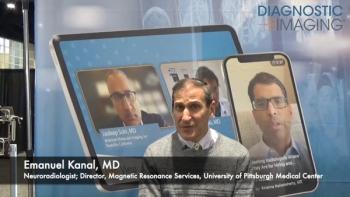
SSFP serves as good start to abdominal MR exams
SSFP serves as good start to abdominal MR exams
The patient’s back pain was too severe to finish the MRI exam. Her conventional full MRI abdominal study was supposed to take 25 minutes, but-fortunately for her-she could tolerate lying in the scanner long enough to complete the protocol’s first sequence. Those five minutes were just enough time to complete the three-plane survey with a steady-state free precession pulse sequence. Her radiologist used it alone to diagnose her renal cell carcinoma.
The case is hypothetical, but the benefits of SSFP in the abdomen are real. A study of 114 patients by Dr. Michael Dutka and colleagues at Thomas Jefferson Univers ity Hospital in Philadelphia has established the value of rapid surveys with SSFP at beginning of comprehensive abdominal MRI exams (JMRI 2008;27[1]:198-203).
First described in 1986, SSFP has been widely adopted as the pulse sequence of choice for cardiac MRI. Its ability to freeze anatomic motion and to produce high contrast-to-noise ratio for bright blood imaging makes it a natural choice for imaging rapidly moving organs, but its limited ability to depict metastases or solid lesions in solid organs contributed to its slower adoption elsewhere in the body.
A comprehensive MRI survey involves heavily and moderately T2-weighted turbo spin-echo, T1-weighted dual gradient-echo, fat-suppressed 3D dynamic contrast-enhanced gradient-echo, delayed postcontrast fat-suppressed T1-weighted, and fat-suppressed T2-weighted pulse se quences. Radial MR cholangiopancreatography is also often performed.
Dutka, an MRI fellow, and his fellow researchers demonstrated SSFP was five times faster than the full abdominal MRI exam and detected 87.3% of clinically important findings and 93.3% of malignancies identified on the full exam.
“SSFP alone is not as definitive as a full MR exam, but it is a very meaningful survey,” said Dr. Donald Mitchell, chief of body MRI at Thomas Jefferson and a coauthor of the study. “It should be incorporated at the beginning of every abdominal MRI exam.”
Newsletter
Stay at the forefront of radiology with the Diagnostic Imaging newsletter, delivering the latest news, clinical insights, and imaging advancements for today’s radiologists.




























